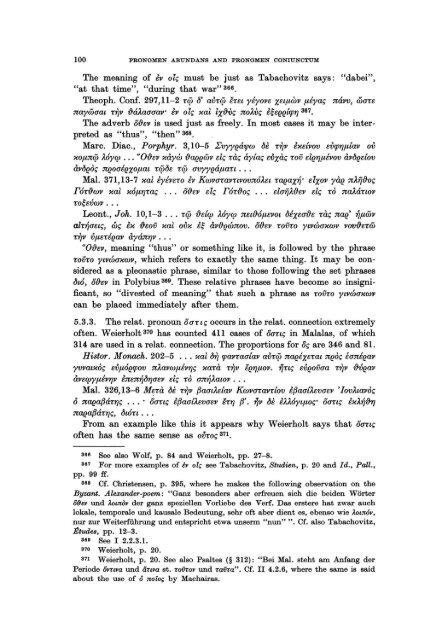Pronomen Abundans and Pronomen Coniunctum. A ... - DWC
Pronomen Abundans and Pronomen Coniunctum. A ... - DWC
Pronomen Abundans and Pronomen Coniunctum. A ... - DWC
Create successful ePaper yourself
Turn your PDF publications into a flip-book with our unique Google optimized e-Paper software.
100 PRONOMEN ABUNDANS AND PRONOMEN CONIUNCTUM<br />
The meaning of l/l olç must be just as Tabachovitz says: "dabei",<br />
"at that time", "during that war" 366.<br />
Theoph. Conf. 297,11-2 Ti[> 15' aVTi[> ËTu yéyove XUf-lwv f-léyaç návv, Q)0'T8<br />
naywO'at T~V {}áAaO'O'av' lP olç xal lxi}Vç nOAvç è~eeetrprJ 367.<br />
The adverb 8{}ev is used just as freely. In most cases it may be interpreted<br />
as "thus", "then" 368.<br />
Marc. Diac., Porphyr. 3,10-5 Evyyeá1pw !5è T~V èxelvov eVrprJf-ltav ov<br />
x0f-lni[> AÓycp ..• "O{}ev xàyw {}U(!ewv elç Tàç áytaç WXàç TOV ele'fJf-lÉvov àv!5eelov<br />
àv!5eoç neoO'éeXof-lat Ti[>!5e Ti[> O'vyyeáf-lan . ..<br />
Mal. 371,13-7 xal èyéveTo èv KwvO'TavnvovnóAu Taeax~' elxov yàe nAij{}oç<br />
rÓT{}WV xal XÓf-l'fJTaÇ ... 8{}ev elç rÓT{}OÇ . .• elO'ijA{}ev elç TO naAánov<br />
To~evwv . ..<br />
Leont., Joh. 10,1-3 ... Ti[> {}elcp AÓycp nU{}Óf-levot !5txeO'{}e Tàç nU(!' ~f-lwv<br />
alr:~O'etç, wç èx {}eov xal ovx è~ àv{}eómov. 8{}ev TOVTO yLVWO'XWV vov{}e7:w<br />
T~V Vf-ledeav àyM'fJV . ..<br />
"O{}ev, meaning "thus" or something like it, is followed by the phrase<br />
TOVTO yLVWO'XWV, which refers to exactly the same thing. It may be considered<br />
as a pleonastic phrase, similar to those following the set phrases<br />
!5tÓ, 8{}ev in Polybius 369. These relative phrases have become so insignificant,<br />
so "divested of meaning" that such a phrase as TOVTO yLVWO'XWV<br />
can be placed immediately af ter them.<br />
5.3.3. The relat. pronoun 80'TtÇ occurs in the relat. connection extremely<br />
of ten. Weierholt37o has counted 411 cases of 80'nç in Malalas, of which<br />
314 are used in arelat. connection. The proportions for 8ç are 346 <strong>and</strong> 81.<br />
Hi8tor. Monach. 202-5 ... xal &J g;avTaO'tav aVTi[> nU(!éxeTat neoç ÉO'néeav<br />
yvvatxoç eVf-lÓeg;ov nAaVWf-lÉv'fJç xaTà T~V le'fJf-lov. fjnç eveovO'a T~V {Meav<br />
, k~".1\ ' \ '1<br />
avecpYf-lc"'IV enen'fJu'fJO'ev uç TO O'n'fJAawv . ..<br />
Mal. 326, 13-6 M~Tà !5è TiJv {3amAelav KWVO'TavTtov è{3aO'tAevO'ev ' IovAtavoç<br />
Ó nU(!a{3áT'fJç . . . • 80'nç è{3aO'tAevO'ev lT'fJ {3'. ?}v !5è èA).óytf-lOÇ' 8O'Ttç èXA~~<br />
nU(!a{3áT'fJç, !5tón ...<br />
From an example like this it appears why Weierholt says that 80'nç<br />
of ten has the same sense as OVTOÇ 371.<br />
888 See also Wolf, p. 84 <strong>and</strong> Weierholt, pp. 27-8.<br />
887 For more examples of tv ol, see Tabachovitz, Studien, p. 20 <strong>and</strong> Id., Pall.,<br />
pp. 99 ff.<br />
888 Cf. Christensen, p. 395, where he makes the following observation on the<br />
Byzant. Alex<strong>and</strong>er-poem: "Ganz besonders aber erfreuen sich die beiden Wörter<br />
IH)f:II und ÀOl3l:0V der ganz speziellen Vorliebe des Verf. Das erstere hat zwar auch<br />
lokale, temporale und kausale Bedeutung, sehr oft aber dient es, ebenso wie ÀOI3l:6v,<br />
nur zur Weiterführung und entspricht etwa unserm "nun" ". Cf. also Tabachovitz,<br />
Étudea, pp. 12-3.<br />
889 See I 2.2.3.1.<br />
870 Weierholt, p. 20.<br />
871 Weierholt, p. 20. See also Psaltes (§ 312): "Bei Mal. steht am Anfang der<br />
Periode wnva und änva st. TOm-OV und Tam-a". Cf. II 4.2.6, where the same is said<br />
about the use of ó :n:oioç by Machairas.
















